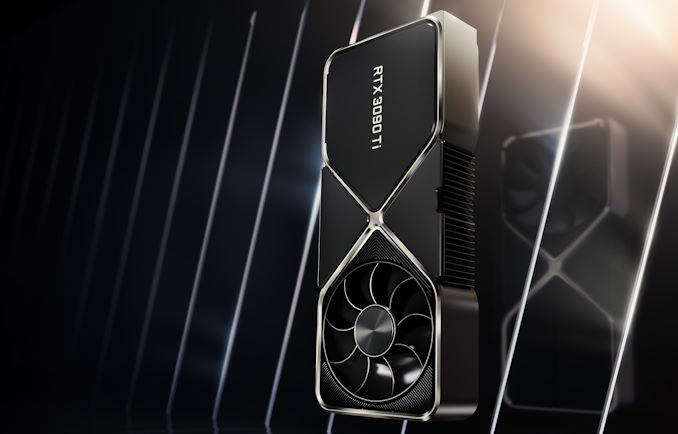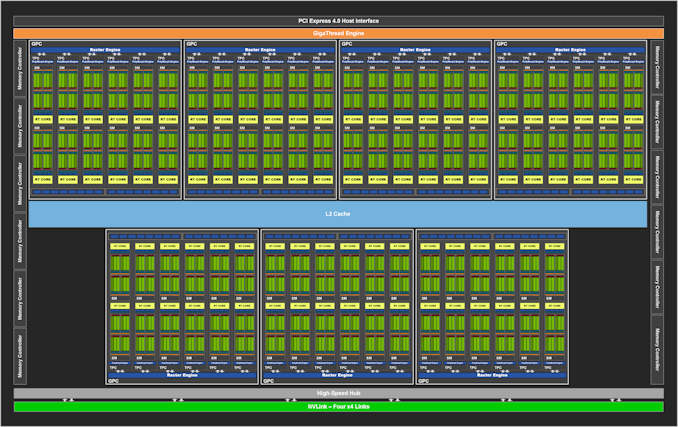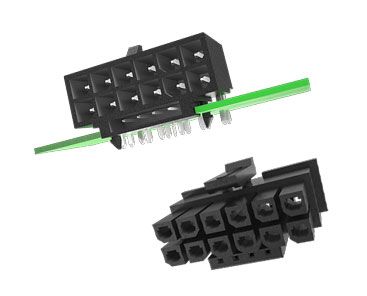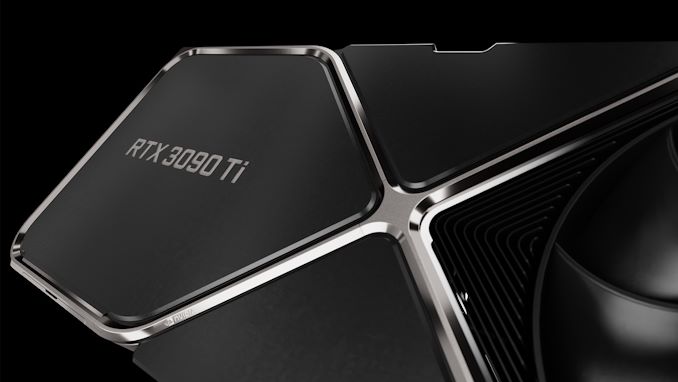NVIDIA Releases GeForce RTX 3090 Ti: Ampere the All-Powerful
by Ryan Smith on March 29, 2022 9:00 AM EST
Back in January during their CES 2022 keynote, NVIDIA teased the GeForce RTX 3090 Ti, an even more powerful version of NVIDIA’s flagship card for the high-end gaming and content creation markets. At the time, NVIDIA told us to expect more information later in January, only for January (and February) to come and go without further mention of the card. But now, in the waning days of March, the GeForce RTX 3090 Ti’s day has come, as NVIDIA is launching their new flagship video card today.
So what is the RTX 3090 Ti? In short, it’s every last bit of performance that NVIDIA can muster out of their Ampere architecture – the swan song for an architecture that has carried NVIDIA through the last 18 months. Whereas the original RTX 3090 left a bit of performance on the table for yield or performance reasons, such as a couple of SMs or keeping TDPs to just 350 Watts, RTX 3090 Ti leaves all of that behind. It’s all the Ampere that Ampere can be, with a fully-enabled GA102 GPU, better GDDR6X memory, and few (if any) limits on performance.
But Ampere unconstrained is going to cost you. While the original RTX 3090 launched at an already high $1499, RTX 3090 Ti ratchets that up further to $1999. And ongoing market distortions (i.e. the chip crunch) will likely compound that further, judging from RTX 3090 prices. But regardless, the RTX 3090 Ti isn’t priced to be competitive; it’s priced to be elite. NVIDIA never did produce a true Titan card for this generation, so the RTX 3090 Ti is set to be the next best thing.
This launch also reflects a more recent tendency from NVIDIA to release one last, speed-bumped card towards the latter part of an architecture’s lifecycle as memory technologies improve. The GTX 1080 received a low-key variant with 11Gbps GDDR5X, and now the RTX 3090 Ti is taking a similar tack with its 21Gbps GDDR6X. Neither of these bumps immensely changed the performance calculus for their respective cards, but as video cards are nothing if not perpetually bandwidth starved, the extra bandwidth is one more way to unlock just a bit more performance from these cards.
| NVIDIA GeForce Specification Comparison | |||||||
| RTX 3090 Ti | RTX 3090 | RTX 3080 Ti | RTX 3080 | Titan RTX | |||
| CUDA Cores | 10752 | 10496 | 10240 | 8704 | 4608 | ||
| ROPs | 112 | 112 | 112 | 96 | 96 | ||
| Boost Clock | 1.86GHz | 1.7GHz | 1.67GHz | 1.71GHz | 1.77GHz | ||
| Memory Clock | 21Gbps GDDR6X | 19.5Gbps GDDR6X | 19Gbps GDDR6X | 19Gbps GDDR6X | 14Gbps GDDR6 | ||
| Memory Bus Width | 384-bit | 384-bit | 384-bit | 320-bit | 384-bit | ||
| VRAM | 24GB | 24GB | 12GB | 10GB | 24GB | ||
| Single Precision Perf. | 40 TFLOPS | 35.7 TFLOPS | 34.1 TFLOPS | 29.8 TFLOPS | 16.3 TFLOPS | ||
| Tensor Perf. (FP16) | 160 TFLOPS | 143 TFLOPS | 136 TFLOPS | 119 TFLOPS | 130 TFLOPS | ||
| Tensor Perf. (FP16-Sparse) | 320 TFLOPS | 285 TFLOPS | 273 TFLOPS | 238 TFLOPS | 130 TFLOPS | ||
| TDP | 450W | 350W | 350W | 320W | 280W | ||
| GPU | GA102 | GA102 | GA102 | GA102 | TU102 | ||
| Transistor Count | 28B | 28B | 28B | 28B | 18.6B | ||
| Architecture | Ampere | Ampere | Ampere | Ampere | Turing | ||
| Manufacturing Process | Samsung 8nm | Samsung 8nm | Samsung 8nm | Samsung 8nm | TSMC 12nm "FFN" | ||
| Launch Date | 03/29/2022 | 09/24/2020 | 06/03/2021 | 09/17/2020 | 12/2018 | ||
| Launch Price | MSRP: $1999 | MSRP: $1499 | MSRP: $1199 | MSRP: $699 | MSRP: $2499 | ||
Diving into the specs, the RTX 3090 Ti is NVIDIA’s forth and seemingly final desktop GA102-based card, and the first card to ship with a fully-enabled GA102. There are no disabled SMs here or cut-down memory busses. All 28 billion transistors are finally in play.
With that said, the net change over the RTX 3090 is 2 SMs – NVIDIA is going from 82 of 84 SMs enabled to all 84 up and running. So the number of additional SMs is not particularly significant from a performance perspective, amounting to a roughly 2.5% increase in SM hardware. Rather, it’s a good illustration of how NVIDIA is employing every technique they can to wring out every last bit of performance from the card, and how they’re comfortable enough with GA102 yields to finally base a product around the fully-enabled chip.
The bigger factor influencing GPU performance is arguably clockspeeds. NVIDIA has raised the base clockspeed to 1.56GHz, and meanwhile the boost clock rating – the average clockspeed of the card in gaming workloads – is now 1.86GHz. That’s a roughly 160Mhz (9%) improvement over the RT 3090’s boost clock, and it applies to all aspects of the chip equally, from the CUDA cores to the ROPs. So everything is getting faster throughout.
In order to keep the even hungrier beast fed, NVIDIA has also stepped up their game with respect to memory technology, and marking one of the few true technological improvements between the original RTX 3090 and the new RTX 3090 Ti. For their new flagship card, NVIDIA is using second generation, 16Gbit GDDR6X memory chips, which have only recently become available. These higher capacity chips can run faster, and they allow NVIDIA to outfit all 24GB of memory using just 12 chips along the front of the card, instead of having to use the 24 chip clamshell configuration that was employed by the original RTX 3090.
The reduction in memory chip counts not only improves power consumption, but it means NVIDIA and partners no longer have to worry about cooling toasty GDDR6X chips on the back of their cards, which was one of the original RTX 3090’s design drawbacks. Instead, everything is on the same side as the GPU, and can be cooled by the card’s massive vapor chamber and heatsink setup.
NVIDIA is also using this opportunity to crank up the memory clockspeeds, going from 19.5Gbps on the RTX 3090 to a flat 21Gbps on the new card. To be sure, this isn’t a massive clockspeed bump, but the extra 8% in memory bandwidth helps to ensure the similarly faster GPU is kept fed, at least to the same degree as the original RTX 3090. However, it does mean that NVIDIA has invested most of their power savings from halving the GDDR6X chip count on higher memory clockspeeds, so there is little overall change in GDDR6X power consumption.
And more so than anything else about the RTX 3090 Ti, “power” is the operative word for the new card. The original RTX 3090, despite its then chart-topping 350W TDP, is still prone to throttling to stay at TDP. In fact, this goes for most Ampere cards; NVIDIA’s GA10x GPUs can generally exceed 2GHz, but they require a whole lot of power to get there. And no card chugs power more than the RTX 3090.
So for their ultimate variant of the card, NVIDIA has updated the RTX 3090 Ti to support a TDP of 450 Watts, a full 100 Watts (29%) higher than the original card. By significantly raising the power limits of the card, the RTX 3090 Ti is designed to be able to run the GA102 GPU at its highest turbo clockspeeds more often – though even then, it’s telling that the game clock is only 1.86GHz. This, above all else, underscores how NVIDIA is looking to wring out nearly every last bit of performance out of GA102; power consumption limits have very nearly been thrown out the window. And yet even then, there are going to be add-in-board partner designs for the RTX 3090 Ti that call for almost 500W.
The fact that NVIDIA is going to be shipping a 450W video card is certainly an interesting choice, and one I find a bit worrying. This is almost certainly not going to be the last card to ship with such a high TDP, so this is very much a sign of things to come. And while we’ve long grown accustomed to flagship cards that push things to ridiculous levels, I am very concerned about what this may mean for more mainstream video cards down the line. Video card TDPs have been going up across the board for the last several years, and a 450W flagship card is a sign that it won’t be stopping any time soon. But that’s a discussion for another day.
In order to support this higher TDP, in turn, NVIDIA has updated both their power delivery and cooling systems. On the power delivery front, the RTX 3090 Ti will be the first card to use the new 12VHPWR connector from the just-launched ATX 3.0 power supply specification. The 12VHPWR connector is designed to deliver up to 600W over 16 pins, paving the way for some very high-powered video cards and other accelerators. The 12VHPWR connector replaces the similar 12-pin connector NVIDIA has been using on the other RTX 30 series cards, serving the same function. Though it should be noted that while NVIDIA is using the physical connector, they aren’t making full use of it; RTX 3090 Ti will not be using the variable power delivery aspects, and instead will be operating in 450W mode at all times.
As for cooling a 450W video card, NVIDIA will once more be setting the tempo here with their Founders Edition (reference) card. NVIDIA is once again using their 3-slot cooler from the original RTX 3090, though according to the company they have made unspecified tweaks to their their vapor chamber cooler to improve the cooler’s performance. Still, any improvements in cooling efficiency are almost certainly going to be overshadowed by the card’s greatly increased TDP, so at the end of the day the solution is going to involve moving a whole lot of air to constantly dissipate 450W of heat.
Target Market & Partner Cards
Throughout the entire lifetime of the current RTX 3090, NVIDIA’s flagship GeForce video card has always sat on an odd spot between being a gaming card and being a content creation or compute card. While NVIDIA has a separate line of cards specifically for professional visualization (the A-series cards, aka the former Quadro family), the fastest GeForce (or GeForce-adjacent card) has always served to fill the gap between GeForce and Quadro, for users who need a top-tier card with lots of memory, but not necessarily the extra bells and whistles that come from a ProViz card. In recent years that gap has been covered by the Titan cards, and this generation it’s been the RTX 3090.
Unsurprisingly then, NVIDIA is going the same route with the RTX 3090 Ti, aiming it at both gamers and content creators. For gamers who need the fastest NVIDIA card available (and money is no object), then the RTX 3090 Ti will fill that role. Meanwhile NVIDIA is also chasing content creators who need more than the 12GB of VRAM available on the RTX 3080 Ti, but aren’t ready to step up to a ProViz card. And in fact, NVIDIA is pushing the latter a lot more than the former; while the RTX 3090 Ti is a fast gaming card, NVIDIA themselves admit that “today's most graphically intense games don't take full advantage of the horsepower the RTX 3090 Ti offers. And that's fine.”
Consequently, NVIDIA’s published performance estimates for the new card are chiefly aimed around content creation. Gaming performance is expected to be 9% ahead of the original RTX 3090 and 52% faster than the Turing-based Titan RTX, while rendering performance is anywhere between 42%-102% faster than that same Titan RTX. So along with content creation being a higher priority for NVIDIA, the company is also clearly trying to entice current creators on RTX Titan/2080 Ti to upgrade to the fastest Ampere card.
As for the card supply, both NVIDIA and its partners will be supplying cards. NVIDIA is once again producing a “limited edition” Founders Edition version of this card, which in the US will be sold exclusively through Best Buy. And, since the RTX 3090 Ti requires a new power connector and more power overall, NVIDIA’s FE card will come with a 3x8pin adapter, up from the 2x8-pin adapter included with the regular RTX 3090.
Meanwhile the board partners will be doing their own things, as is usually the case with well-established GPUs. The power requirements are going to be similarly high – and the coolers similarly beefy. According to NVIDIA, all of the usual suspects will have cards, and we’ve already seen designed from EVGA, Colorful, and Asus. This includes listings for $1999 base-model cards, but as the GPU market continues to be weird, it’s anyone’s guess how many of those are available and how long they’ll last, even at these prices.
Otherwise, sizing up NVIDIA and AMD’s product stacks, the RTX 3090 Ti all but stands alone in terms of price and positioning. Backstopping it will be the original RTX 3090, which according to NVIDIA will remain in full production (and will need to fall in price to accommodate the new card). And below that will be the RTX 3080 Ti, followed by AMD’s top Radeon part, the Radeon RX 6900 XT.
| Q2 2022 GPU Product Lineups (Theoretical MSRPs, Please Check eBay For Actual Availabiltiy) |
|||||
| AMD | Price | NVIDIA | |||
| $1999 | GeForce RTX 3090 Ti | ||||
| $1499 | GeForce RTX 3090 | ||||
| $1199 | GeForce RTX 3080 Ti | ||||
| N/A | GeForce RTX 3080 12GB | ||||
| Radeon RX 6900 XT | $999 | ||||
| Radeon RX 6800 XT | $649/$699 | GeForce RTX 3080 | |||
| Radeon RX 6800 | $579/$599 | GeForce RTX 3070 Ti | |||
| Radeon RX 6700 XT | $479/$499 | GeForce RTX 3070 | |||
Source: NVIDIA










_thumb.jpg)









88 Comments
View All Comments
Adonisds - Tuesday, March 29, 2022 - link
How can that single small cooler be enough for a 450W card? How noise will the founders edition be?DanNeely - Tuesday, March 29, 2022 - link
It's a 3 slot cooler, an inch taller than the card and about 2 inches longer than a standard full length card. It's a lot more massive than a standard GPU cooler.A good gaming headset is probably still advised for the FE card though.
Pneumothorax - Tuesday, March 29, 2022 - link
My 3090 FE is already a pretty noisy card despite 4 Noctua 140mm fans in a 5000D airflow case. It runs much quieter if I undervolt it to 250 watts instead of the stock wattage. With the same cooler + 100 watts more, this card really needs water cooling unless you like to game with headphones on.DanNeely - Tuesday, March 29, 2022 - link
Blower cards are going to be loud no matter what you do. System builders like them though because even if the customer wants a crap case with minimal ventilation the blower will just ramp up like a fighter jet engine at takeoff and suck air in through whatever gaps the case has and blast it out the back without thermal throttling severely like an open cooling card in a badly ventilated case.Khanan - Tuesday, March 29, 2022 - link
It’s not a blower card. Nvidia doesn’t use blower cards since 2018.Samus - Wednesday, March 30, 2022 - link
I think ditching blowers was a huge mistake. Axial fans are much less efficient than "squirrel cages" and they have the inherent benefit of ejecting the majority of the heat out of the case, creating additional negative pressure to exchange cold air. It's a win-win.I'm sure the eggheads at nVidia has their reasons. I lack a degree in thermal dynamics so who am I to judge. But my ITX case requires a blower and until nVidia or their partners offer a blower option on their newer cards I'm perfectly happy sticking with my EVGA 2080 or going to AMD next time - they have plenty of cards with blowers...
TheinsanegamerN - Tuesday, April 5, 2022 - link
It was a mix of noise and the heatsink. Squirrel cage fans are ust plain loud. Every blower card reviewed over the years was just plain loud. Compared to the open frame 6900xts barely breaking 34db, its a pretty noticeable difference.The other is the heatsink. In a blower card, the size of your heatsink is reall ylimited, doing heatpipes near impossible unless its a monster like the GTX 480. Open frame cooler heatsinks are WAY bigger.
Pneumothorax - Tuesday, March 29, 2022 - link
As Khanan said, it's not a blower card. Either way, it's hard to dissipate 450 watts of heat in your computer case. Throw in another 200 watts from the 12900K and you're cooking.TheinsanegamerN - Tuesday, April 5, 2022 - link
Well if they would jsut bring back side fans instead of those goofy plexiglass panels it wouldnt be an issue. The high end GPUs I've seen in HAF 922 and 932 chassis have 0 heat issues!bigvlada - Tuesday, April 5, 2022 - link
Cooler Master ATCS 840 was designed to tame screamers like these. Same 230mm fans like HAF but pure aluminium case. You could probably put second PSU and custom water cooling and still have enough room for all the cards and 12 drives (6*5.25 and 6*3.5").